Twenty years ago this month, RFC 1883 was published: Internet Protocol, Version 6 (IPv6) Specification. So what's an Internet Protocol, and what's wrong with the previous five versions? And if version 6 is so great, why has it only been adopted by half a percent of the Internet's users each year over the past two decades?
10 percent!
First the good news. According to Google's statistics, on December 26, the world reached 9.98 percent IPv6 deployment, up from just under 6 percent a year earlier. Google measures IPv6 deployment by having a small fraction of their users execute a Javascript program that tests whether the computer in question can load URLs over IPv6. During weekends, a tenth of Google's users are able to do this, but during weekdays it's less than 8 percent. Apparently more people have IPv6 available at home than at work.

Google also keeps a map of the world with IPv6 deployment numbers per country, handily color-coded for our convenience. More and more countries are turning green, with the US at nearly 25 percent IPv6, and Belgium still leading the world at almost 43 percent. Many other countries in Europe and Latin America and even Canada have turned green in the past year or two, but a lot of others are still stubbornly staying white, with IPv6 deployment figures well below one percent. Some, including China and many African nations, are even turning red or orange, indicating that IPv6 users in those countries experience significantly worse performance than IPv4 users.

The past four years, IPv6 deployment increased by a factor 2.5 each year: from 0.4 percent by the end of 2011 to 1 percent in late 2012, 2.5 percent at the end of 2013, and 6 percent a year ago. Having 4 percent of the world's population Google's users gain IPv6 connectivity in a year is a huge number, but considering that outside Africa, there's no more IPv4 addresses to be had, the remaining 90 percent IPv4 users are still in for a rough ride.
Of course existing IPv4 addresses aren't going anywhere, but without a steady supply of fresh IP addresses, it's hard to keep the Internet growing in the manner it's accustomed to. For instance, when moving to a new place, you may discover your new ISP can't give you your own IPv4 address anymore, and puts you behind a Carrier Grade NAT (CGN) that makes you share one with the rest of the neighborhood. Some applications, especially ones that want to receive incoming connections, such as video chat, may not work well through certain CGNs.
If a 67 percent increase per year is the new normal, it'll take until summer 2020 until the entire world has IPv6 and we can all stop slicing and dicing our diminishing stashes of IPv4 addresses.
Why the delay?
IPv6 has been around for two decades now. So why are we still measuring IPv6 deployment in percentage points per year, while Wi-Fi didn't exist yet in 1995 and has used up the entire alphabet to label its variants since then, with many users on IEEE 802.11ac today?
In order for a Web browser to show a video of a cat riding a roomba, a bunch of video data needs to be transferred. But that's the easy part: we have more than enough cabling and radio transmitters in place to make that happen. The hard part is knowing what the light pulses and voltages in these cables and the radio waves going through the air actually mean so the receiver can make heads or tails out of it. For that, we have protocols and standards.
Most of the time, when a standard gets updated or replaced, only two devices need to care. For instance, with the explosive growth of the cat on roomba category, Youtube may have needed to upgrade its 10 Gigabit Ethernet connections to 100 Gigabit Ethernet. That's a serious upgrade of the affected servers and routers, but the rest of the internet doesn't care. We've added four zeros to the Ethernet and Wi-Fi speeds over the past decades. But Ethernet, FDDI, Wi-Fi, PPP, Packet over SONET, Resilient Packet Ring and other standards just add their own control data when a packet is transmitted and then remove it after the packet is received at the other end of the line (or radio link). So I have no way of knowing whether a packet I receive from Youtube was transmitted over 10 Gigabit Ethernet or 100 Gigabit Ethernet or something else completely: when I get it, the packet looks the same in each case. This makes upgrading the bandwidth of the internet very easy: just upgrade one connection at a time.
Other standards govern the interpretation of the data by the ultimate receiver. When Youtube upgraded its videos from Adobe Flash to HTML5, obviously the software on Youtube's end had to be upgraded as well as our browsers so those knew how to properly request the videos using HTML5 and then play them as intended. However, the routers along the way don't care. They just see lots of small data packets coming by. That the content of those packets is now formatted slightly differently doesn't influence the way the data is carried through the wires and sent in the right direction. So upgrading applications that run over the internet is harder than increasing the bandwidth because there will always be people visiting Youtube with old browsers. But it's still relatively straightforward: deploy the new standard, but fall back to the old one if necessary. This way, we were able to move from postage stamp sized Sorenson Video-compressed videos to 4k H.264 in about a decade and a half.
Unfortunately, the Internet Protocol is different. The sending system needs to create an IP packet. Then, all the routers along the way (and any firewalls and load balancers) need to look at that IP packet to be able to send it on its way. Finally, the receiving system needs to be able to understand the IP packet to get at the information contained in it. Even worse, the applications on the sending and receiving ends often have to look at IP addresses and thus know the difference between an IPv4 address and an IPv6 address. So we can't just upgrade a server and a client application, or two systems on opposite ends of a cable. We need to upgrade all servers, all clients, all routers, all firewalls, all load balancers, and all management systems to IPv6 before we can retire IPv4 and thus free ourselves of its limitations.
So even though all our operating systems and nearly all network equipment supports IPv6 today (and has for many years in most cases), as long as there's just one device along the way that doesn't understand the new protocol—or its administrator hasn't gotten around to enabling it—we have to keep using IPv4. In that light, having ten percent of users communicate with Google over IPv6 isn't such a bad result.
reader comments
210